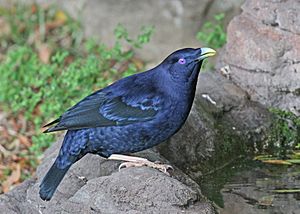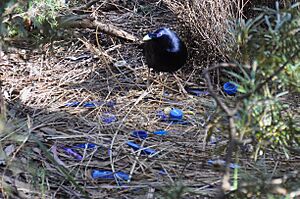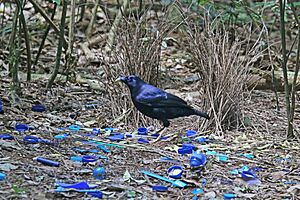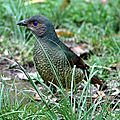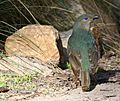Satin bowerbird facts for kids
Quick facts for kids Satin bowerbird |
|
|---|---|
 |
|
| Male | |
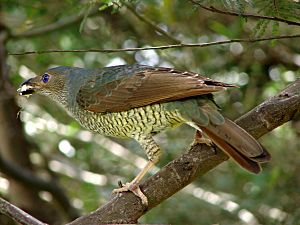 |
|
| Female | |
| Conservation status | |
| Scientific classification | |
| Kingdom: | |
| Phylum: | |
| Class: | |
| Order: | |
| Family: | |
| Genus: |
Ptilonorhynchus
Kuhl, 1820
|
| Species: |
P. violaceus
|
| Binomial name | |
| Ptilonorhynchus violaceus |
|
The satin bowerbird (Ptilonorhynchus violaceus) is a special type of bowerbird. It lives only in eastern Australia.
Sometimes, a rare natural mix happens between a satin bowerbird and a regent bowerbird. This special bird is called Rawnsley's bowerbird.
Contents
What Does a Satin Bowerbird Look Like?
Adult male satin bowerbirds have amazing violet-blue eyes. Their feathers look black, but they have a super shiny, deep blue color. This happens because of how light bounces off their feathers. Younger males look just like females, so people often get them mixed up.
Female satin bowerbirds have striking blue eyes. Their upper bodies are green-brown or completely brown. Their undersides are lighter with a unique net-like pattern. People might mistake them for the green catbird or spotted catbird.
Where Do Satin Bowerbirds Live?
The satin bowerbird is common in eastern Australia. You can find them in rainforests and tall, wet forests. Their home stretches from southern Queensland down to Victoria. There is also a separate group living in the Wet Tropics of northern Queensland.
What Do Satin Bowerbirds Eat?
Satin bowerbirds mostly eat fruit when they are adults. They also munch on leaves and a small amount of seeds and insects. When they are baby birds in the nest, they eat beetles, grasshoppers, and cicadas. They keep eating these insects until they can fly.
These birds are not picky eaters at all. They really like many of the plants that people have brought to Australia. In fact, they help spread the seeds of some weedy plants. Examples include camphor laurel, European olive trees, and different types of privet.
Gardeners sometimes get upset with satin bowerbirds. This is because the birds often raid fruit and vegetable gardens. Satin bowerbirds can be quite pushy when they are looking for food. They often try to scare other birds away from fruit trees.
How Do Satin Bowerbirds Find a Mate?
Satin bowerbirds have very interesting ways of finding a mate. Male birds build special stick structures called bowers. They decorate these bowers with blue, yellow, and shiny items. These decorations can be berries, flowers, or even plastic things. They use items like ballpoint pens, drinking straws, and clothes pegs. As the males get older, they tend to use more blue objects.
Female birds visit these bowers to choose which male they will mate with. Besides building their bowers, males also perform special dances. These dances are meant to impress the females. However, sometimes females might see these dances as a bit threatening. Only the female builds the nest and takes care of the eggs.
Scientists have studied how females choose their mates. This process happens in three main steps:
- First, females visit the bowers when the males are not there. This happens before any nests are built.
- Second, females visit the bowers again when the males are present and performing their dances. This is still before nests are built.
- Third, after nests are built, females visit a few chosen bowers. This usually leads to mating with just one male.
Studies show that young females (in their first or second year of breeding) are mostly influenced by how the bowers look. This means the first step is very important for them. Older females are not as bothered by the males' intense dances. They choose their mates more based on the males' dancing skills. It is thought that as males get older, they get better at seeing colors. This helps them pick more blue objects for their bowers. We don't yet know if other bowerbird species do the same thing.
Nesting and Life Cycle
Satin bowerbirds build their nests between October and February. They usually lay two eggs, but sometimes one or three. The nest is shallow and made of twigs. Leaves from Eucalyptus or Acacia trees are placed on top. These leaves turn brown as the eggs are laid, which might help hide the nest.
The eggs are cream-colored with brown streaks. They are quite large for the bird's size, weighing about 19 grams (0.67 ounces). Eggs are laid every other day and hatch at different times after 21 days.
Young bowerbirds can fly three weeks after hatching. However, they still rely on their mother for about two more months. They leave her care around May or June, at the start of the southern winter.
Female satin bowerbirds can start having babies when they are two or three years old. Males, however, do not become fully mature until they are seven or eight years old. This is when their feathers change completely to the shiny blue-black of an adult. The satin bowerbird lives longer than almost any other songbird that has been studied. The average lifespan is about eight or nine years. The oldest known satin bowerbird lived for twenty-six years in the wild!
Gallery
Images for kids
See also
 In Spanish: Pergolero satinado para niños
In Spanish: Pergolero satinado para niños



